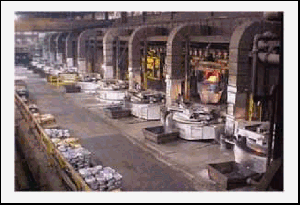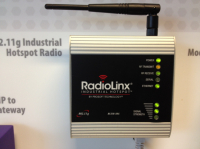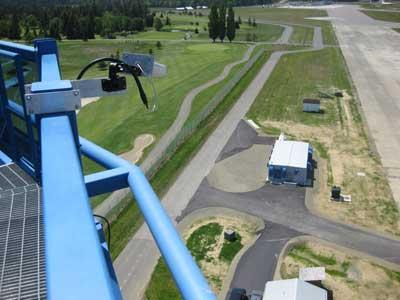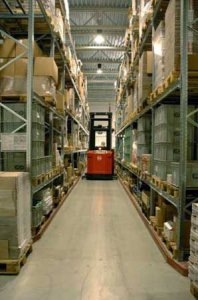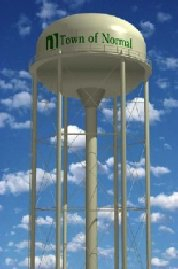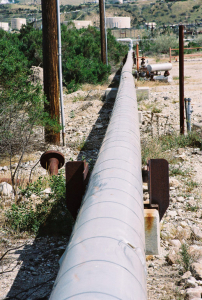The overhead crane gracefully rides down 240 feet of track with its 8,500 lbs. of cargo.
Iron Manufacturer Goes Wireless
The material is placed into one of ten, single-channel induction furnaces and melted to a temperature of 2,750 degrees Fahrenheit to make molten iron. Hot metal carriers then transport the molten iron to an automatic pouring unit. Along the way, an alloy is added that converts the base iron to ductile iron that will be made into finished castings.
The manufacturer has six plants in Wisconsin, Indiana, and Tennessee. At plant No. 4 in Marionette, Wisconsin, 1,500 tons of ductile iron is melted every day to make castings for automotive, agriculture, hydraulics, heavy truck, material handling, power transmission, and off-highway vehicles. With over 3,600 people employed, the combined melt capacity of the six plants is over 9,500 tons of gray and ductile iron each day.
Plant No. 4 prides itself on using state-of-the-art technology in its production processes.
“When we began looking at ways to improve the efficiency and ability of the melt department at Plant 4, we found there were actually three main factors to look at in making decisions on how to proceed,” said the project manager for the wireless automation project:
∙ Record-keeping: To meet ISO and customer requirements, the materials used and chemistries of the iron had to be traceable throughout the entire production process. For the melt department, this meant keeping a record of the incoming charge material from the vendors and alloy used in the process, along with the amounts of each material used in a charge, plus the time the charge was melted, removed from the furnace, and delivered to the automatic pouring units. They found that the inventory records of what was delivered and what was consumed seldom matched.
∙ Accuracy: Many of the parts made by the company are safety-critical components. The chemistries and dimensions must be exact. Following the purpose of their quality management system - “To establish, document and maintain a quality system in accordance with current editions of ANSI/ASQC QS9002 and ISO/TS 16949” - this problem had to be addressed. Even if the scales were in perfect calibration, the information being logged was only as good as the operator’s entries. They needed to eliminate as much paperwork, phone, and two-way radio communications as possible.
∙ Cost reduction: The company rates the production cost in man-hours per ton of iron. When the melt department started looking at how to reduce costs, they had to look at staffing and what each position added to the value of the finished product.
“The first phase of automation was the alloy addition,” the project manager said. “There were two people on each shift manually weighing up the alloy in pails up to a total weight of 200 lbs. They then opened up a hatch on the lid of the ladles used to transport the molten iron. With the heat and flame coming out of the hatch, they would dump the alloy into the ladles. There was a high rate of injury in this job from strains and burns. Recording what was added to each ladle was done on a clipboard that later had to be typed into the system for record-keeping. We were relying on the person to read and record the information into the system accurately.”
The plant was able to reduce seven staff positions by incorporating an automated batching system with the alloy addition weights calculated by a PLC with information provided by the metal lab on a touch screen. The results were real-time accurate weights and record-keeping.
Completing this part of the project cost over $250,000 in material and labor. However, the cost savings in eliminating the six full-time positions and one relief man’s hours provided an annual savings estimated at $320,000.
Next they turned their attention to the charge yard, where the batches to be melted are made. There, two overhead cranes with electromagnets lift material and place it on an automated shaker system. The melt control room operator would use a telephone to communicate the required weight of each of the four items that make up a batch to the preheat control operator. The preheat control operator would relay this information to the two crane operators using a two-way radio and type it into his PC. As the crane operators would lift and place the material on the shakers, they would call down the weights of each item and the preheat operator would type that information into the computer.
“Distractions would cause the preheat operator to miss what weight numbers were called down, and which shaker they were placed in,” the project manager said. “This delayed the process of getting material to the preheat units. The total amount of material needed for each item could not be lifted at one time, so the crane operators would add the amounts in their head or jot it on a paper. If a crane operator forgot what he had said, or wasn’t watching the scale display, they would guess at what was placed in the shakers and invalid information was recorded. In looking over the amounts of material used and compared with the delivery slips, the inventory seldom ever matched. If the resulting chemistry of the iron was wrong because of operator error, there was no way to backtrack the cause of the problem with any accuracy.”
The company knew they needed to look at a system that could get information to and from the overhead cranes automatically and eliminate the human error. Since the cranes are mobile equipment, this presented a unique problem to get a communications system to function properly. They finally decided to place a separate PLC on each of the cranes and chose SIMATIC® S7 units, which were compatible with the Texas Instruments 505 series that was already running in preheat control.
“One of our other plants had in place a PROFIBUS radio system that looked promising, but we found it wouldn’t handle the volume of information we wanted to transmit and receive,” the project manager said. “In speaking with our PLC vendor, Professional Control Corp., they suggested we try using wireless Ethernet radios for PLC-to-PLC communication. There was some concern there may be cross-talk with the wireless bar code readers on our forklifts already in use. Also there was concern the 4.5 million watts of power used in the melt department might somehow interfere with the signals.
“The first step in testing was to hardwire the Texas Instruments and Siemens® Ethernet cards on a bench test to verify the ability to communicate the database information. Our PLC vendor made arrangements for ProSoft Technology, the wireless Ethernet radio manufacturer, to loan us a couple of units for testing. Testing proved out that the wireless Ethernet solution would work. We already were using the Ethernet port on the preheat control PLC to talk with the server, so we simply added another Ethernet card available from C.T.I. to the PLC rack in the preheat control room. This card then connected to the master radio.”
An S7™ PLC with Ethernet, the other I/O cards needed, and the ProSoft radios were installed on each crane. Mounting the touch screens in the cab of each crane on swing arms made it possible for each operator to position them comfortably.
“We were impressed with the ease of setting up the wireless Ethernet radios using the provided software that gave us the signal strength information for the best mounting location,” the project manager said.
The time saved by not having to relay the information verbally allows them to make up to six batches in advance, instead of three previously. This allows for smooth transitions between the different chemistries needed for production. Crane-to-crane communication allows both cranes to see what the other has already added to the batch, speeding up the process and preventing duplication errors. The parts and labor cost for this portion of the upgrade was $22,887, while the total annual savings were $173,380.
With the success of their first wireless Ethernet installation on mobile equipment under their belt, the plant addressed another problem: their hot metal carriers, or HMCs. There are over 950 feet of monorail loops through the facility on which the HMCs travel. The HMC drivers were using two-way radio communication to exchange information with the metal lab, melt control room operator, and each other. The amount of time between receiving the alloy, filling the ladle, delivering the treated iron to the pouring device, and getting the iron poured in the sand mold is critical. Once the iron is treated in the ladle, it has to be poured into the mold within 25 minutes or the chemistry will change and the iron is unusable. It must then be removed from the pouring device. This is called “pigging.” Depending on the chemistry and the job specifications, “fresh” treated iron may have to be added to the pouring device and possibly pigged to flush the vessel. Iron that has been pigged has to run through the whole melt process again, thus costing twice as much for melting and treating the same amount of product poured. The cost of iron at the spout is about 19 cents a pound, so reprocessing an 8,000-pound ladle of iron cost the company an extra $1,520. If the chemistries weren’t within specifications, there was uncertainty as to the cause.
“We identified some of the problems as being missed communications between the metal lab, melt control room operator, and the HMC drivers,” the project manager said. “Other problems were taking the wrong iron weight, getting iron from the wrong furnace number, and delivering iron to the wrong pouring unit.”
Putting PLCs and wireless Ethernet communications on the HMCs wasn’t as easy as in the crane application. One of the major hurdles to overcome was power loss on the power rail distribution. If the rails lose power because of a collector shoe arcing, or for any other reason, the HMCs will switch to diesel power to drive the hydraulics. If the PLC were to shut down, they’d be having the same problems as before.
“We solved this problem by adding another 12-volt battery on the HMC next to the diesel starting battery,” the project manager said. “This battery is kept charged with a ‘float’-type charger powered by the 120 volts on the unit. The 12 volts is then brought to an inverter to convert it back to 120VAC. This system is only used to filter and keep power on the PLC, Ethernet radio and the operator touch panel in the cab. It gives us up to 48 hours of run time so repairs can be made to the electrical distribution system.”
Another problem that had to be overcome was that the HMCs were not always in line-of-sight of the master radio. To overcome this problem, they placed one repeater unit out in the plant. The HMCs communicate with the repeater and then to the master unit. The metal lab, melt control room, the alloy station, and the three metal carriers exchange information in real time.
By adding an incremental encoder to an idler wheel on the drive, they were able to track each carrier throughout the plant with an accuracy of ¼ inch. Mapping out the monorail locations of each furnace pour spout and pouring device receiver location resolved one of their major issues. Now if any HMC stops in the wrong location while taking or delivering iron, an audible alarm sounds on that HMC, and the lab and the melt operator’s screens indicate the alarm is active.
“In tracking the time and frequency of the alarm going off, we found there were 14 times in the first month of recording data that, had it not been for the alarm, there may have been chemistry problems in the final product,” the project manager said.
“Probably one of the biggest lessons learned from completing this project was the amount of data we thought was good was actually bad,” he continued. “Now whenever there is a mistake involving human error, the problem is addressed by making it error-proof using technology if possible.”
The annual total savings at one plant totaled $600,000.
The company is currently making plans to use ProSoft Technology’s wireless radios instead of underground fiber between their power generator building and their main plant.
Learn more about ProSoft Technology’s Wireless Solutions here.





